|  |
Ekkeland Götze in KwaZulu Natal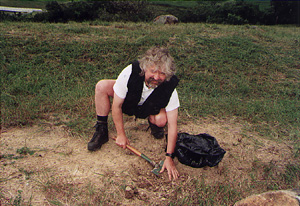 |
KwaDukuza Museum in Stanger
Ekkeland Goetze, Bongani Cecil Mdunge from KwaZulu Monuments Council and Inkosi (Chief) Gumede.
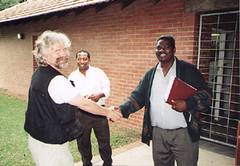 | King Shaka's Kraal "KwaDukuza" - "Place of the lost person"
Excavation of soil (Nş 325) at the place where king Shaka (1787-1828) was killed in KwaDukuza, the second capital of king Shaka
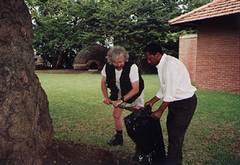 | Fort Pearson at Tugela
River First bridge-head of the English invasion units at the place of ultimatum (1879)
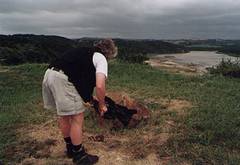 | Induna (Tribal chief) Gwala's Kraal
Formal request at Induna Samuel Gwala for excavating soil in king Shaka's first military kraal KwaBulawayo.
Kathleen von Kapff (documentation, co-ordination), E.G., Induna Gwala, B. C. Mdunge
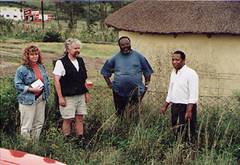 | Monument of KwaBulawayo the "Place of Killing"
Soil sample Nş 323 of KwaBulawayo, the first royal residence of the "Black Napoleon of Africa"
E.G., B. C. Mdunge, K. v. Kapff
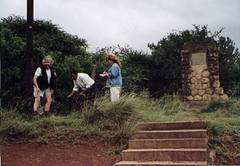 | Plaque KwaBulawayo Monument
"Here stood the principal Kraal of Shaka, when Mzilikazi broke away from Shaka circa 1826 he eventually established a new kraal with the same name in Southern Rhodesia where later the city of Bulawayo arose."
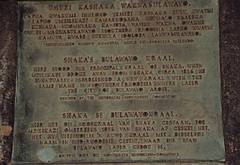 | King Shaka's Kraal KwaBulawayo
E.G. searching for the excavating site in the "Forbidden Village", the closed residence of the tyrant.
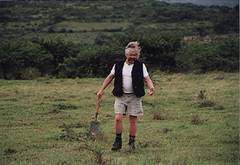 | King Shaka's Kraal KwaBulawayo
Excavation of soil (Nş 322) with the view to the West to the Nkwalini Valley, the birth place of the Zulu nation.
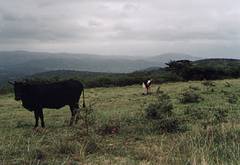 | King Shaka's Kraal KwaBulawayo
Excavation of soil (Nş 322) with the view to the South East.
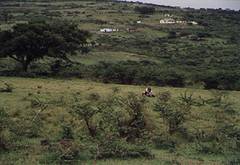 | Coward's Bush Coward's Bush-Monument with bush in the background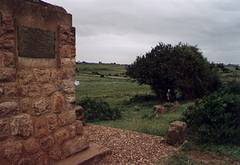 |
Coward's Bush Monument Plaque
"This Kei-Apple Tree is known as coward's Bush. Here Shaka is said to have tested those accused of cowardice in battle. All who flinched were executed."
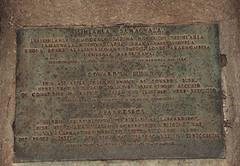 | Coward's Bush
Excavation of soil (Nş 324) under the bush, where thousands encountered a terrible death.
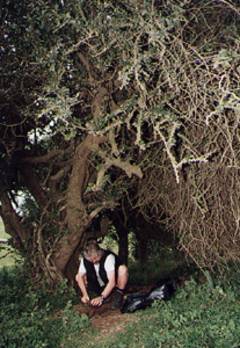 | Cultural Museum Ondini
Barry Marshall(director) talking to E.G.
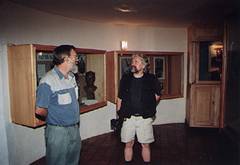 | Cetshwayo's Kraal Ondini - "The Heights"
Director Marshall explains in front of Cetshwayo's hut the meaning of the other royal huts.
K. v. Kapff, E.G., B. Marshall
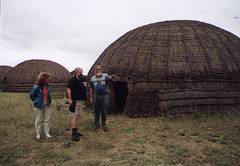 | Cetshwayo's Kraal Ondini - "The Heights"
B. Marshall, K. v. Kapff, E.G. at the entry to king Cetshwayo's hut. The original ground from cow dung originates from 1879, the pillars and the roof were reconstructed.
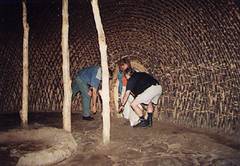 | Cetshwayo's Kraal Ondini - "The Heights"
In the hut of "Inkatha", the most powerful fetish of the Zulu nation.
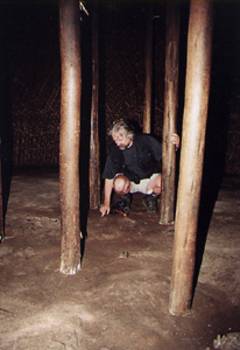 | Cetshwayo's Kraal Ondini - "The Heights"
Excavation of soil sample Nş 322 in the cattle kraal nearby the "rock throne" of Cetshwayo.
E.G., Justice Nxumalo (education officer), K. v. Kapff, B. Marshall.
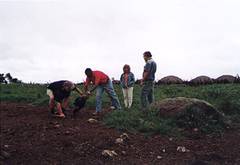 | Cetshwayo's Kraal Ondini - "The Heights"
Goetze receives from Director Marshall a just found broken piece of pottery from the year 1879.
B. Marshall, J. Nxumalo, E.G., Uli von Kapff (co-ordination, photographs).
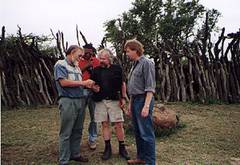 | King Dingaan's Kraal Mgungundlovu - "Plot of the Elephant"
On the Dancing-Square of the Harem in the "Forbidden Village" of the colossal military kraal.
K. v. Kapff, E.G., Eric Buthelezi (Officer KwaZulu Monument Council).
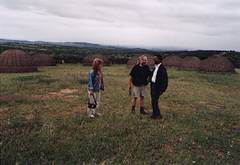 | King Dingaan's Kraal Mgungundlovu - "Plot of the Elephant"
Excavation of soil (Nş 326) from theclosed cattle kraal of the king, King Dingaans hut in the background.
E. Buthelezi and E.G.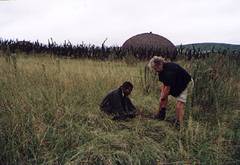 |
King Dingaan's Kraal Mgungundlovu - "Plot of the Elephant"
Excavation of soil (Nş 326) with the Execution Hill in the background.
E.G. and K. v. Kapff
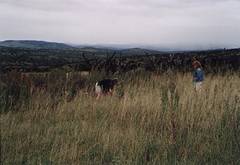 | King Dingaan's Kraal Mgungundlovu - "Plot of the Elephant"
King Dingaan’s reconstructed hut from 1838.
E.G. and E. Buthelezi
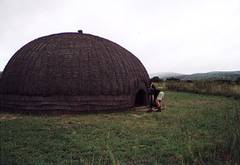 | King Dingaan's Kraal Mgungundlovu - "Plot of the Elephant"
In King Dingaans hut. The 24 pillars were completely decorated with tiny colourful glass beads.
E. Buthelezi, K. v. Kapff, E.G.
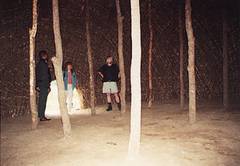 | King Dingaan's Kraal Mgungundlovu - "Plot of the Elephant"
At the still visible foundation of the hut of one of the main wives of Dingaan. The reconstructed king's hut in the background.
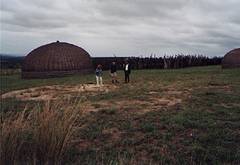 | Emakhosini - The Valley of Kings
Excavation of soil (Nş 316) at the grave of Nkosinkhulu, the "Big Chief"
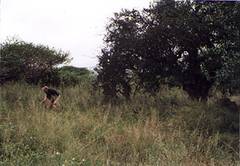 | Emakhosini - The Valley of Kings
Monument of the controversial forefather Nkosinkhulu (ca. 16. century) under a "Umlahlankosi"-tree - "put down" or "bury the king"-tree (Ziziphus mucronata).
E. Buthelezi and E.G.
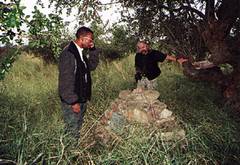 | Emakhosini - The Valley of Kings
Plaque at the monument of chief Nkosinkhulu.
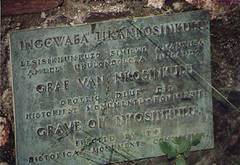 | Execution Hill
Excavation of soil (Nş 316) at the place where thousands of Zulus and hundreds of Europeans were executed. In the background the monument for the murdered Voortrekker Piet Retief. The bright oval behinds marks the location of Dingaan's capital in the year 1838.
E. Buthelezi and E.G.
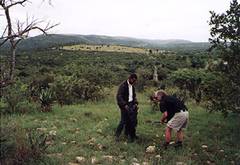 | Emakhosini - The Valley of Kings
The monument of chief Senzangankhona (Ý1816), father of three powerful and historically important kings (Shaka, Dingan and Mpande).
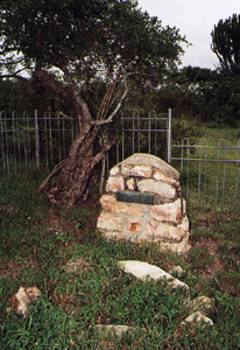 | Emakhosini - The Valley of Kings
Plaque at Senzangankhona's grave.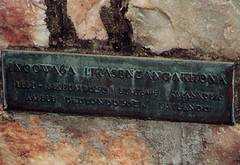 |
|  |
|
